Macroeconomic Trends in Australia: An In-depth Economics Assignment
VerifiedAdded on 2023/06/12
|12
|4372
|275
Essay
AI Summary
This essay provides an in-depth analysis of Australia's macroeconomic trends, focusing on key indicators such as Real GDP growth rate, inflation rate, unemployment rate, and exchange rates between 1990 and 2016. The analysis reveals that while the Real GDP growth rate experiences considerable fluctuations indicative of a business cycle, the inflation and unemployment rates remain relatively stable. The essay also explores the relationship between net exports and real exchange rates, noting that Australia has primarily been a net importer. A comparison of Australia's Cash Rate with the USA's Federal Fund's Rate suggests limited influence of the latter on the former. Overall, the essay paints a positive outlook for the Australian economy, with a cautionary note on potential future inflationary pressures. Desklib offers this essay as a study resource, providing students access to solved assignments and past papers.
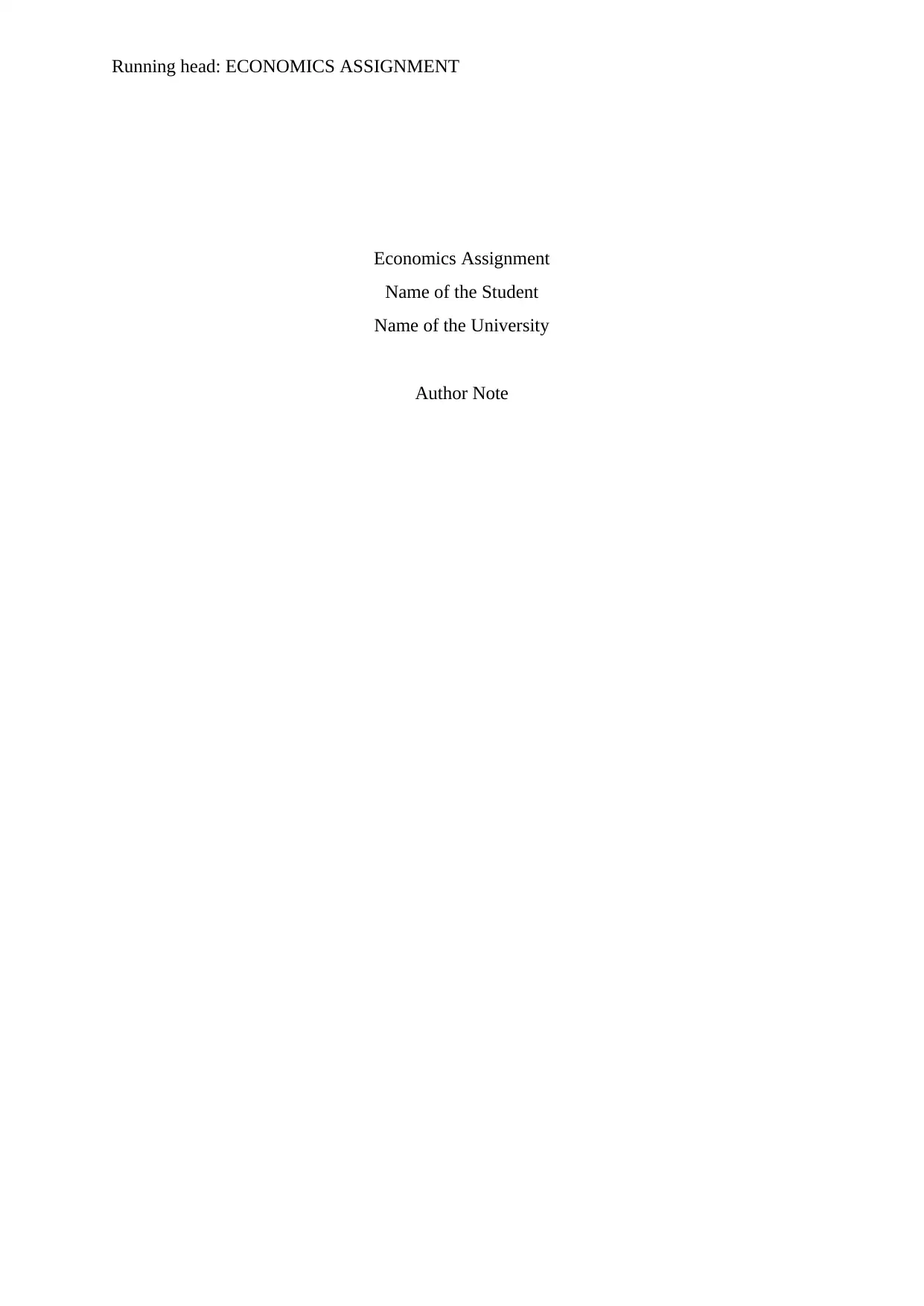
Running head: ECONOMICS ASSIGNMENT
Economics Assignment
Name of the Student
Name of the University
Author Note
Economics Assignment
Name of the Student
Name of the University
Author Note
Paraphrase This Document
Need a fresh take? Get an instant paraphrase of this document with our AI Paraphraser
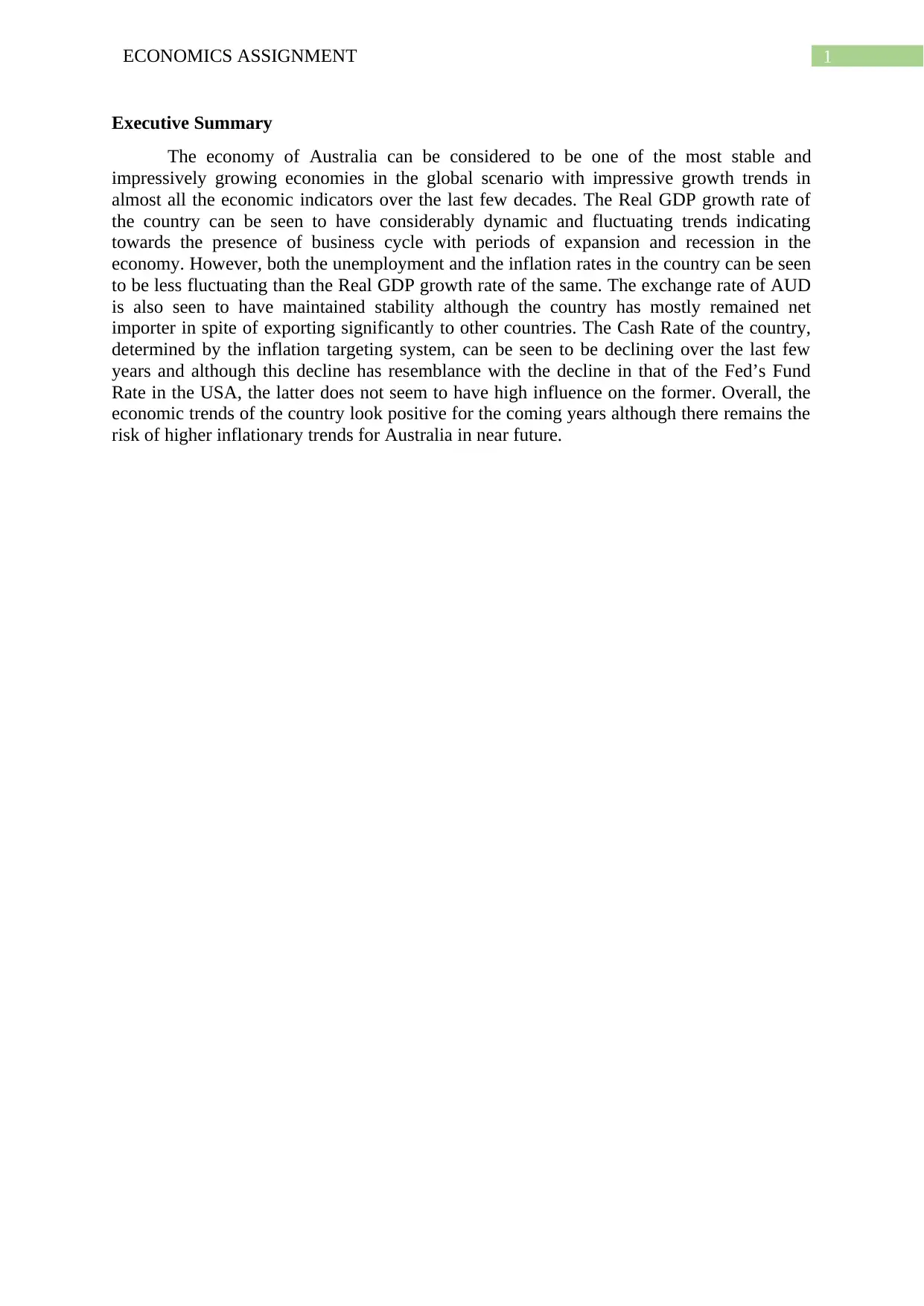
1ECONOMICS ASSIGNMENT
Executive Summary
The economy of Australia can be considered to be one of the most stable and
impressively growing economies in the global scenario with impressive growth trends in
almost all the economic indicators over the last few decades. The Real GDP growth rate of
the country can be seen to have considerably dynamic and fluctuating trends indicating
towards the presence of business cycle with periods of expansion and recession in the
economy. However, both the unemployment and the inflation rates in the country can be seen
to be less fluctuating than the Real GDP growth rate of the same. The exchange rate of AUD
is also seen to have maintained stability although the country has mostly remained net
importer in spite of exporting significantly to other countries. The Cash Rate of the country,
determined by the inflation targeting system, can be seen to be declining over the last few
years and although this decline has resemblance with the decline in that of the Fed’s Fund
Rate in the USA, the latter does not seem to have high influence on the former. Overall, the
economic trends of the country look positive for the coming years although there remains the
risk of higher inflationary trends for Australia in near future.
Executive Summary
The economy of Australia can be considered to be one of the most stable and
impressively growing economies in the global scenario with impressive growth trends in
almost all the economic indicators over the last few decades. The Real GDP growth rate of
the country can be seen to have considerably dynamic and fluctuating trends indicating
towards the presence of business cycle with periods of expansion and recession in the
economy. However, both the unemployment and the inflation rates in the country can be seen
to be less fluctuating than the Real GDP growth rate of the same. The exchange rate of AUD
is also seen to have maintained stability although the country has mostly remained net
importer in spite of exporting significantly to other countries. The Cash Rate of the country,
determined by the inflation targeting system, can be seen to be declining over the last few
years and although this decline has resemblance with the decline in that of the Fed’s Fund
Rate in the USA, the latter does not seem to have high influence on the former. Overall, the
economic trends of the country look positive for the coming years although there remains the
risk of higher inflationary trends for Australia in near future.
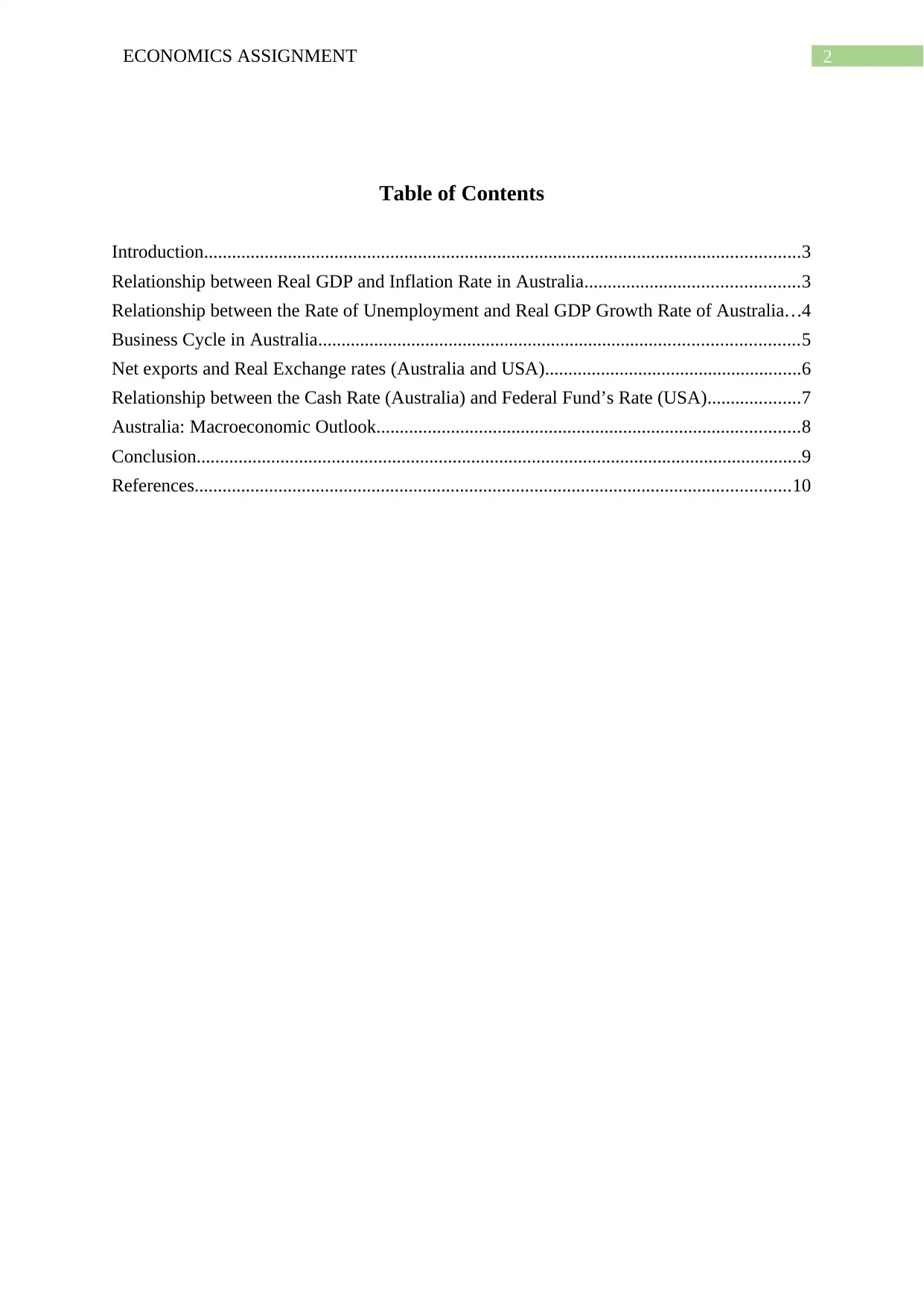
2ECONOMICS ASSIGNMENT
Table of Contents
Introduction................................................................................................................................3
Relationship between Real GDP and Inflation Rate in Australia..............................................3
Relationship between the Rate of Unemployment and Real GDP Growth Rate of Australia...4
Business Cycle in Australia.......................................................................................................5
Net exports and Real Exchange rates (Australia and USA).......................................................6
Relationship between the Cash Rate (Australia) and Federal Fund’s Rate (USA)....................7
Australia: Macroeconomic Outlook...........................................................................................8
Conclusion..................................................................................................................................9
References................................................................................................................................10
Table of Contents
Introduction................................................................................................................................3
Relationship between Real GDP and Inflation Rate in Australia..............................................3
Relationship between the Rate of Unemployment and Real GDP Growth Rate of Australia...4
Business Cycle in Australia.......................................................................................................5
Net exports and Real Exchange rates (Australia and USA).......................................................6
Relationship between the Cash Rate (Australia) and Federal Fund’s Rate (USA)....................7
Australia: Macroeconomic Outlook...........................................................................................8
Conclusion..................................................................................................................................9
References................................................................................................................................10
⊘ This is a preview!⊘
Do you want full access?
Subscribe today to unlock all pages.

Trusted by 1+ million students worldwide
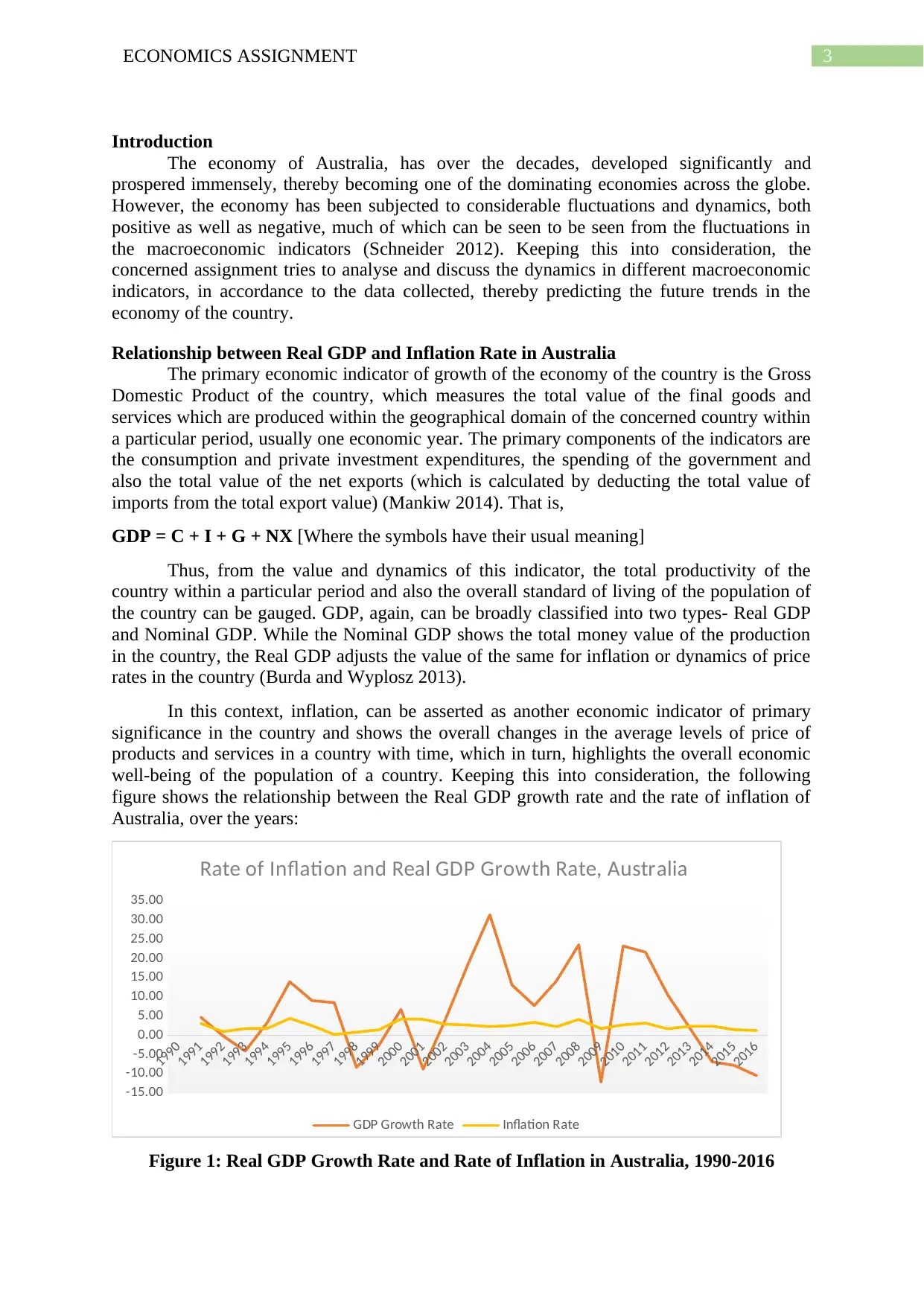
3ECONOMICS ASSIGNMENT
Introduction
The economy of Australia, has over the decades, developed significantly and
prospered immensely, thereby becoming one of the dominating economies across the globe.
However, the economy has been subjected to considerable fluctuations and dynamics, both
positive as well as negative, much of which can be seen to be seen from the fluctuations in
the macroeconomic indicators (Schneider 2012). Keeping this into consideration, the
concerned assignment tries to analyse and discuss the dynamics in different macroeconomic
indicators, in accordance to the data collected, thereby predicting the future trends in the
economy of the country.
Relationship between Real GDP and Inflation Rate in Australia
The primary economic indicator of growth of the economy of the country is the Gross
Domestic Product of the country, which measures the total value of the final goods and
services which are produced within the geographical domain of the concerned country within
a particular period, usually one economic year. The primary components of the indicators are
the consumption and private investment expenditures, the spending of the government and
also the total value of the net exports (which is calculated by deducting the total value of
imports from the total export value) (Mankiw 2014). That is,
GDP = C + I + G + NX [Where the symbols have their usual meaning]
Thus, from the value and dynamics of this indicator, the total productivity of the
country within a particular period and also the overall standard of living of the population of
the country can be gauged. GDP, again, can be broadly classified into two types- Real GDP
and Nominal GDP. While the Nominal GDP shows the total money value of the production
in the country, the Real GDP adjusts the value of the same for inflation or dynamics of price
rates in the country (Burda and Wyplosz 2013).
In this context, inflation, can be asserted as another economic indicator of primary
significance in the country and shows the overall changes in the average levels of price of
products and services in a country with time, which in turn, highlights the overall economic
well-being of the population of a country. Keeping this into consideration, the following
figure shows the relationship between the Real GDP growth rate and the rate of inflation of
Australia, over the years:
1990
1991
1992
1993
1994
1995
1996
1997
1998
1999
2000
2001
2002
2003
2004
2005
2006
2007
2008
2009
2010
2011
2012
2013
2014
2015
2016
-15.00
-10.00
-5.00
0.00
5.00
10.00
15.00
20.00
25.00
30.00
35.00
Rate of Inflation and Real GDP Growth Rate, Australia
GDP Growth Rate Inflation Rate
Figure 1: Real GDP Growth Rate and Rate of Inflation in Australia, 1990-2016
Introduction
The economy of Australia, has over the decades, developed significantly and
prospered immensely, thereby becoming one of the dominating economies across the globe.
However, the economy has been subjected to considerable fluctuations and dynamics, both
positive as well as negative, much of which can be seen to be seen from the fluctuations in
the macroeconomic indicators (Schneider 2012). Keeping this into consideration, the
concerned assignment tries to analyse and discuss the dynamics in different macroeconomic
indicators, in accordance to the data collected, thereby predicting the future trends in the
economy of the country.
Relationship between Real GDP and Inflation Rate in Australia
The primary economic indicator of growth of the economy of the country is the Gross
Domestic Product of the country, which measures the total value of the final goods and
services which are produced within the geographical domain of the concerned country within
a particular period, usually one economic year. The primary components of the indicators are
the consumption and private investment expenditures, the spending of the government and
also the total value of the net exports (which is calculated by deducting the total value of
imports from the total export value) (Mankiw 2014). That is,
GDP = C + I + G + NX [Where the symbols have their usual meaning]
Thus, from the value and dynamics of this indicator, the total productivity of the
country within a particular period and also the overall standard of living of the population of
the country can be gauged. GDP, again, can be broadly classified into two types- Real GDP
and Nominal GDP. While the Nominal GDP shows the total money value of the production
in the country, the Real GDP adjusts the value of the same for inflation or dynamics of price
rates in the country (Burda and Wyplosz 2013).
In this context, inflation, can be asserted as another economic indicator of primary
significance in the country and shows the overall changes in the average levels of price of
products and services in a country with time, which in turn, highlights the overall economic
well-being of the population of a country. Keeping this into consideration, the following
figure shows the relationship between the Real GDP growth rate and the rate of inflation of
Australia, over the years:
1990
1991
1992
1993
1994
1995
1996
1997
1998
1999
2000
2001
2002
2003
2004
2005
2006
2007
2008
2009
2010
2011
2012
2013
2014
2015
2016
-15.00
-10.00
-5.00
0.00
5.00
10.00
15.00
20.00
25.00
30.00
35.00
Rate of Inflation and Real GDP Growth Rate, Australia
GDP Growth Rate Inflation Rate
Figure 1: Real GDP Growth Rate and Rate of Inflation in Australia, 1990-2016
Paraphrase This Document
Need a fresh take? Get an instant paraphrase of this document with our AI Paraphraser

4ECONOMICS ASSIGNMENT
(Source: Abs.gov.au 2018)
From the above figure, showing the dynamics of the rate of inflation and that of the
Real GDP Growth Rate of Australia, over the years (1990-2016), it can be asserted that the
GDP Growth Rate of the country has been subjected to considerable fluctuations, both
positive as well as negative, over the years, with the rate becoming negative in 1993,1998,
2001, 2009 and 2014-2015 onwards (Dyster and Meredith 2012). Much of this can be
attributes to the national or international financial and economic crisis periods (like that in
2008-2009, which marked the occurrence of the Global Financial Crisis) and so on. Again,
the indicator also shows growth rates as high as 30% in 2004 and nearly 25% in 2011.
However, the rate of inflation of the country, unlike that of the former indicator,
shows a highly stable and more or less moderate trend over the concerned period, with the
rates ranging between 1% to 4%. This in turn, indicates towards the presence of an economic
stability and a good health of the economy as a whole contributing to the overall well-being
of the residents of the country (Gregory and Smith 2016).
Relationship between the Rate of Unemployment and Real GDP Growth Rate of
Australia
Apart from the rate of inflation, another economic indicator of considerable
significance in a country, is that of the rate of unemployment in the country. This is because
the level of employment and job creation in a country depicts the economic welfare of the
population of the country as a whole, their purchasing power, demand patterns, which in turn
have implications on the overall economic productivity or GDP of the concerned country
(Argy and Nevile 2016). Keeping this into consideration, the relationship between the rate of
unemployment and Growth Rate of Real GDP can be seen as follows:
1990
1991
1992
1993
1994
1995
1996
1997
1998
1999
2000
2001
2002
2003
2004
2005
2006
2007
2008
2009
2010
2011
2012
2013
2014
2015
2016
-15
-10
-5
0
5
10
15
20
25
30
35
Rate of Unemployment and Real GDP Growth Rate
GDP Growth Rate Unemployment Rate
Figure 2: Rate of Unemployment and Growth Rate of Real GDP in Australia, 1990-2016
(Source: Abs.gov.au 2018)
In the theoretical framework of economics, there is a concept known as the Okun’s
Law, which indicates towards the presence of a relationship between the rate of
(Source: Abs.gov.au 2018)
From the above figure, showing the dynamics of the rate of inflation and that of the
Real GDP Growth Rate of Australia, over the years (1990-2016), it can be asserted that the
GDP Growth Rate of the country has been subjected to considerable fluctuations, both
positive as well as negative, over the years, with the rate becoming negative in 1993,1998,
2001, 2009 and 2014-2015 onwards (Dyster and Meredith 2012). Much of this can be
attributes to the national or international financial and economic crisis periods (like that in
2008-2009, which marked the occurrence of the Global Financial Crisis) and so on. Again,
the indicator also shows growth rates as high as 30% in 2004 and nearly 25% in 2011.
However, the rate of inflation of the country, unlike that of the former indicator,
shows a highly stable and more or less moderate trend over the concerned period, with the
rates ranging between 1% to 4%. This in turn, indicates towards the presence of an economic
stability and a good health of the economy as a whole contributing to the overall well-being
of the residents of the country (Gregory and Smith 2016).
Relationship between the Rate of Unemployment and Real GDP Growth Rate of
Australia
Apart from the rate of inflation, another economic indicator of considerable
significance in a country, is that of the rate of unemployment in the country. This is because
the level of employment and job creation in a country depicts the economic welfare of the
population of the country as a whole, their purchasing power, demand patterns, which in turn
have implications on the overall economic productivity or GDP of the concerned country
(Argy and Nevile 2016). Keeping this into consideration, the relationship between the rate of
unemployment and Growth Rate of Real GDP can be seen as follows:
1990
1991
1992
1993
1994
1995
1996
1997
1998
1999
2000
2001
2002
2003
2004
2005
2006
2007
2008
2009
2010
2011
2012
2013
2014
2015
2016
-15
-10
-5
0
5
10
15
20
25
30
35
Rate of Unemployment and Real GDP Growth Rate
GDP Growth Rate Unemployment Rate
Figure 2: Rate of Unemployment and Growth Rate of Real GDP in Australia, 1990-2016
(Source: Abs.gov.au 2018)
In the theoretical framework of economics, there is a concept known as the Okun’s
Law, which indicates towards the presence of a relationship between the rate of
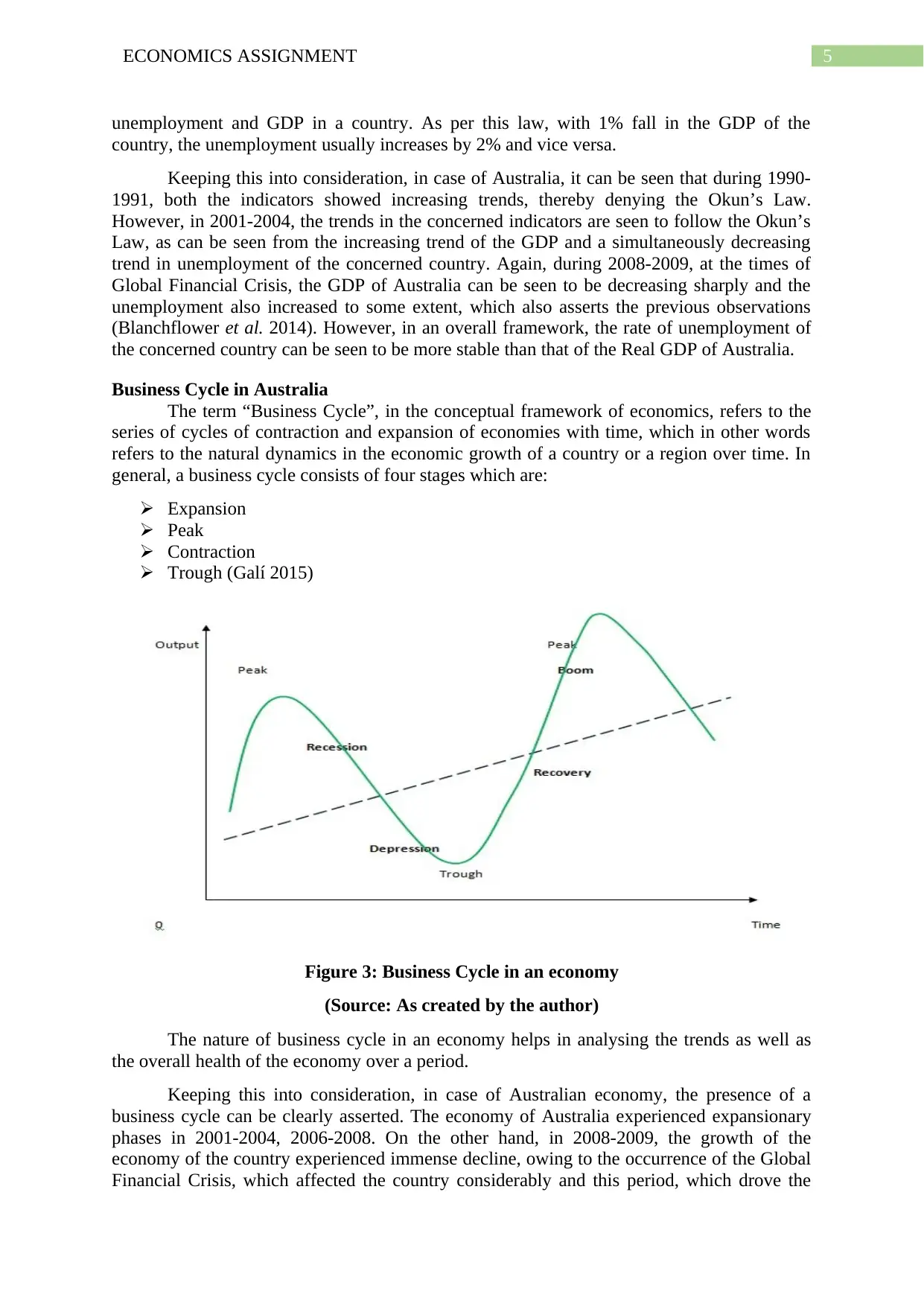
5ECONOMICS ASSIGNMENT
unemployment and GDP in a country. As per this law, with 1% fall in the GDP of the
country, the unemployment usually increases by 2% and vice versa.
Keeping this into consideration, in case of Australia, it can be seen that during 1990-
1991, both the indicators showed increasing trends, thereby denying the Okun’s Law.
However, in 2001-2004, the trends in the concerned indicators are seen to follow the Okun’s
Law, as can be seen from the increasing trend of the GDP and a simultaneously decreasing
trend in unemployment of the concerned country. Again, during 2008-2009, at the times of
Global Financial Crisis, the GDP of Australia can be seen to be decreasing sharply and the
unemployment also increased to some extent, which also asserts the previous observations
(Blanchflower et al. 2014). However, in an overall framework, the rate of unemployment of
the concerned country can be seen to be more stable than that of the Real GDP of Australia.
Business Cycle in Australia
The term “Business Cycle”, in the conceptual framework of economics, refers to the
series of cycles of contraction and expansion of economies with time, which in other words
refers to the natural dynamics in the economic growth of a country or a region over time. In
general, a business cycle consists of four stages which are:
Expansion
Peak
Contraction
Trough (Galí 2015)
Figure 3: Business Cycle in an economy
(Source: As created by the author)
The nature of business cycle in an economy helps in analysing the trends as well as
the overall health of the economy over a period.
Keeping this into consideration, in case of Australian economy, the presence of a
business cycle can be clearly asserted. The economy of Australia experienced expansionary
phases in 2001-2004, 2006-2008. On the other hand, in 2008-2009, the growth of the
economy of the country experienced immense decline, owing to the occurrence of the Global
Financial Crisis, which affected the country considerably and this period, which drove the
unemployment and GDP in a country. As per this law, with 1% fall in the GDP of the
country, the unemployment usually increases by 2% and vice versa.
Keeping this into consideration, in case of Australia, it can be seen that during 1990-
1991, both the indicators showed increasing trends, thereby denying the Okun’s Law.
However, in 2001-2004, the trends in the concerned indicators are seen to follow the Okun’s
Law, as can be seen from the increasing trend of the GDP and a simultaneously decreasing
trend in unemployment of the concerned country. Again, during 2008-2009, at the times of
Global Financial Crisis, the GDP of Australia can be seen to be decreasing sharply and the
unemployment also increased to some extent, which also asserts the previous observations
(Blanchflower et al. 2014). However, in an overall framework, the rate of unemployment of
the concerned country can be seen to be more stable than that of the Real GDP of Australia.
Business Cycle in Australia
The term “Business Cycle”, in the conceptual framework of economics, refers to the
series of cycles of contraction and expansion of economies with time, which in other words
refers to the natural dynamics in the economic growth of a country or a region over time. In
general, a business cycle consists of four stages which are:
Expansion
Peak
Contraction
Trough (Galí 2015)
Figure 3: Business Cycle in an economy
(Source: As created by the author)
The nature of business cycle in an economy helps in analysing the trends as well as
the overall health of the economy over a period.
Keeping this into consideration, in case of Australian economy, the presence of a
business cycle can be clearly asserted. The economy of Australia experienced expansionary
phases in 2001-2004, 2006-2008. On the other hand, in 2008-2009, the growth of the
economy of the country experienced immense decline, owing to the occurrence of the Global
Financial Crisis, which affected the country considerably and this period, which drove the
⊘ This is a preview!⊘
Do you want full access?
Subscribe today to unlock all pages.

Trusted by 1+ million students worldwide

6ECONOMICS ASSIGNMENT
economic growth rate from its peak in 2008, to a negative trough in 2009, can be termed as a
recessionary or contractionary phase for the country, following which the economy of the
country can be seen to enter into a phase of recovery. These movements in the economic
growth of the country indicates towards the clear presence of business cycle in the economy
of Australia (Morley and Piger 2012).
Net exports and Real Exchange rates (Australia and USA)
A significant component of the GDP of a country, as discussed above, is the value of
the net exports of the country, which in turn shows the value of total exports less the value of
total imports by the same. On the other hand, the exchange rate of the domestic currency of a
country is the price of the same in terms of the value of the domestic currency of the country
in comparison. In general, while measuring the exchange rate dynamics of a country, the
value of the currency of the USA, that is the value of US dollar is taken as a yardstick and the
concerned currency and its exchange rate is measured with respect to the value of the dollar.
Keeping this into account, the exchange rate of AUD against USD and the net exports
of the same, within the time period of 1990-2016, as well as the relationship between the two
variables (if any) can be seen from the following figure:
1990
1991
1992
1993
1994
1995
1996
1997
1998
1999
2000
2001
2002
2003
2004
2005
2006
2007
2008
2009
2010
2011
2012
2013
2014
2015
2016
-30.00
-25.00
-20.00
-15.00
-10.00
-5.00
0.00
5.00
10.00
15.00
20.00
Net Exports and Exchange Rate
Exchange Rate Net Exports
Figure 4: Relationship between the Real exchange rate and Net Exports
(Source: Abs.gov.au 2018)
As is evident from the above figure, the rate of change of the exchange rate of the
domestic currency of Australia with that of the US dollars, has remained more or less stable,
over the concerned period of time. However, as far as the international trade dynamics of the
country is concerned, it can be seen that the net exports of Australia, barring a few
fluctuations, has most of the time, remained negative, which in turn, indicates towards the
fact that country has over the years remained a net importer of goods and services from other
countries. Only in 2011, the country can be seen to have positive net exports (Handley 2014).
Australia in general exports minerals, precious metals like gold, iron ore, coal and petroleum
gas and is the 23rd largest exporting countries in the global scenario. However, the country is
one of the biggest importers in the world, the import basket of the country mainly consisting
of automobiles, refined petroleum, computers and technological commodities.
economic growth rate from its peak in 2008, to a negative trough in 2009, can be termed as a
recessionary or contractionary phase for the country, following which the economy of the
country can be seen to enter into a phase of recovery. These movements in the economic
growth of the country indicates towards the clear presence of business cycle in the economy
of Australia (Morley and Piger 2012).
Net exports and Real Exchange rates (Australia and USA)
A significant component of the GDP of a country, as discussed above, is the value of
the net exports of the country, which in turn shows the value of total exports less the value of
total imports by the same. On the other hand, the exchange rate of the domestic currency of a
country is the price of the same in terms of the value of the domestic currency of the country
in comparison. In general, while measuring the exchange rate dynamics of a country, the
value of the currency of the USA, that is the value of US dollar is taken as a yardstick and the
concerned currency and its exchange rate is measured with respect to the value of the dollar.
Keeping this into account, the exchange rate of AUD against USD and the net exports
of the same, within the time period of 1990-2016, as well as the relationship between the two
variables (if any) can be seen from the following figure:
1990
1991
1992
1993
1994
1995
1996
1997
1998
1999
2000
2001
2002
2003
2004
2005
2006
2007
2008
2009
2010
2011
2012
2013
2014
2015
2016
-30.00
-25.00
-20.00
-15.00
-10.00
-5.00
0.00
5.00
10.00
15.00
20.00
Net Exports and Exchange Rate
Exchange Rate Net Exports
Figure 4: Relationship between the Real exchange rate and Net Exports
(Source: Abs.gov.au 2018)
As is evident from the above figure, the rate of change of the exchange rate of the
domestic currency of Australia with that of the US dollars, has remained more or less stable,
over the concerned period of time. However, as far as the international trade dynamics of the
country is concerned, it can be seen that the net exports of Australia, barring a few
fluctuations, has most of the time, remained negative, which in turn, indicates towards the
fact that country has over the years remained a net importer of goods and services from other
countries. Only in 2011, the country can be seen to have positive net exports (Handley 2014).
Australia in general exports minerals, precious metals like gold, iron ore, coal and petroleum
gas and is the 23rd largest exporting countries in the global scenario. However, the country is
one of the biggest importers in the world, the import basket of the country mainly consisting
of automobiles, refined petroleum, computers and technological commodities.
Paraphrase This Document
Need a fresh take? Get an instant paraphrase of this document with our AI Paraphraser
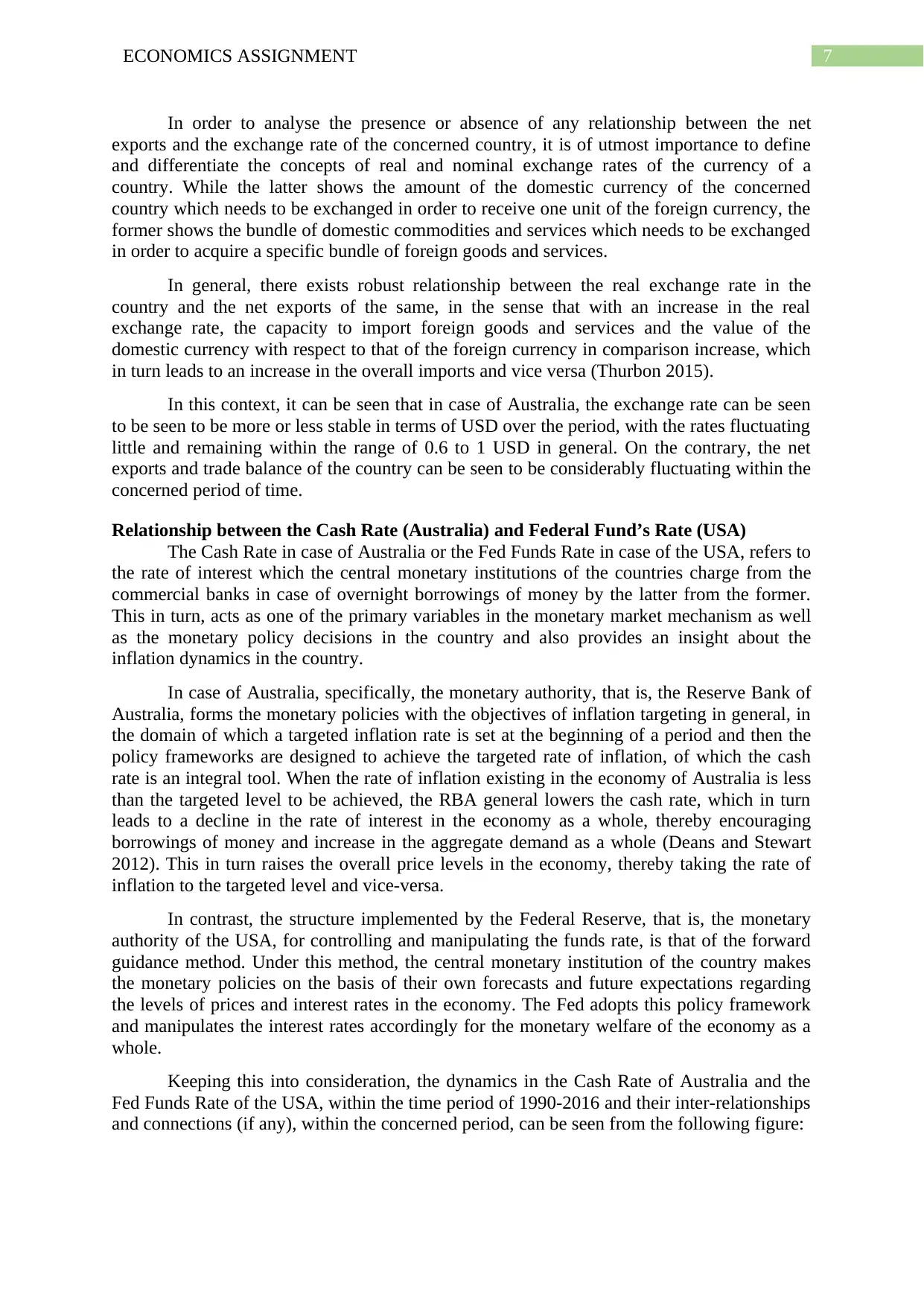
7ECONOMICS ASSIGNMENT
In order to analyse the presence or absence of any relationship between the net
exports and the exchange rate of the concerned country, it is of utmost importance to define
and differentiate the concepts of real and nominal exchange rates of the currency of a
country. While the latter shows the amount of the domestic currency of the concerned
country which needs to be exchanged in order to receive one unit of the foreign currency, the
former shows the bundle of domestic commodities and services which needs to be exchanged
in order to acquire a specific bundle of foreign goods and services.
In general, there exists robust relationship between the real exchange rate in the
country and the net exports of the same, in the sense that with an increase in the real
exchange rate, the capacity to import foreign goods and services and the value of the
domestic currency with respect to that of the foreign currency in comparison increase, which
in turn leads to an increase in the overall imports and vice versa (Thurbon 2015).
In this context, it can be seen that in case of Australia, the exchange rate can be seen
to be seen to be more or less stable in terms of USD over the period, with the rates fluctuating
little and remaining within the range of 0.6 to 1 USD in general. On the contrary, the net
exports and trade balance of the country can be seen to be considerably fluctuating within the
concerned period of time.
Relationship between the Cash Rate (Australia) and Federal Fund’s Rate (USA)
The Cash Rate in case of Australia or the Fed Funds Rate in case of the USA, refers to
the rate of interest which the central monetary institutions of the countries charge from the
commercial banks in case of overnight borrowings of money by the latter from the former.
This in turn, acts as one of the primary variables in the monetary market mechanism as well
as the monetary policy decisions in the country and also provides an insight about the
inflation dynamics in the country.
In case of Australia, specifically, the monetary authority, that is, the Reserve Bank of
Australia, forms the monetary policies with the objectives of inflation targeting in general, in
the domain of which a targeted inflation rate is set at the beginning of a period and then the
policy frameworks are designed to achieve the targeted rate of inflation, of which the cash
rate is an integral tool. When the rate of inflation existing in the economy of Australia is less
than the targeted level to be achieved, the RBA general lowers the cash rate, which in turn
leads to a decline in the rate of interest in the economy as a whole, thereby encouraging
borrowings of money and increase in the aggregate demand as a whole (Deans and Stewart
2012). This in turn raises the overall price levels in the economy, thereby taking the rate of
inflation to the targeted level and vice-versa.
In contrast, the structure implemented by the Federal Reserve, that is, the monetary
authority of the USA, for controlling and manipulating the funds rate, is that of the forward
guidance method. Under this method, the central monetary institution of the country makes
the monetary policies on the basis of their own forecasts and future expectations regarding
the levels of prices and interest rates in the economy. The Fed adopts this policy framework
and manipulates the interest rates accordingly for the monetary welfare of the economy as a
whole.
Keeping this into consideration, the dynamics in the Cash Rate of Australia and the
Fed Funds Rate of the USA, within the time period of 1990-2016 and their inter-relationships
and connections (if any), within the concerned period, can be seen from the following figure:
In order to analyse the presence or absence of any relationship between the net
exports and the exchange rate of the concerned country, it is of utmost importance to define
and differentiate the concepts of real and nominal exchange rates of the currency of a
country. While the latter shows the amount of the domestic currency of the concerned
country which needs to be exchanged in order to receive one unit of the foreign currency, the
former shows the bundle of domestic commodities and services which needs to be exchanged
in order to acquire a specific bundle of foreign goods and services.
In general, there exists robust relationship between the real exchange rate in the
country and the net exports of the same, in the sense that with an increase in the real
exchange rate, the capacity to import foreign goods and services and the value of the
domestic currency with respect to that of the foreign currency in comparison increase, which
in turn leads to an increase in the overall imports and vice versa (Thurbon 2015).
In this context, it can be seen that in case of Australia, the exchange rate can be seen
to be seen to be more or less stable in terms of USD over the period, with the rates fluctuating
little and remaining within the range of 0.6 to 1 USD in general. On the contrary, the net
exports and trade balance of the country can be seen to be considerably fluctuating within the
concerned period of time.
Relationship between the Cash Rate (Australia) and Federal Fund’s Rate (USA)
The Cash Rate in case of Australia or the Fed Funds Rate in case of the USA, refers to
the rate of interest which the central monetary institutions of the countries charge from the
commercial banks in case of overnight borrowings of money by the latter from the former.
This in turn, acts as one of the primary variables in the monetary market mechanism as well
as the monetary policy decisions in the country and also provides an insight about the
inflation dynamics in the country.
In case of Australia, specifically, the monetary authority, that is, the Reserve Bank of
Australia, forms the monetary policies with the objectives of inflation targeting in general, in
the domain of which a targeted inflation rate is set at the beginning of a period and then the
policy frameworks are designed to achieve the targeted rate of inflation, of which the cash
rate is an integral tool. When the rate of inflation existing in the economy of Australia is less
than the targeted level to be achieved, the RBA general lowers the cash rate, which in turn
leads to a decline in the rate of interest in the economy as a whole, thereby encouraging
borrowings of money and increase in the aggregate demand as a whole (Deans and Stewart
2012). This in turn raises the overall price levels in the economy, thereby taking the rate of
inflation to the targeted level and vice-versa.
In contrast, the structure implemented by the Federal Reserve, that is, the monetary
authority of the USA, for controlling and manipulating the funds rate, is that of the forward
guidance method. Under this method, the central monetary institution of the country makes
the monetary policies on the basis of their own forecasts and future expectations regarding
the levels of prices and interest rates in the economy. The Fed adopts this policy framework
and manipulates the interest rates accordingly for the monetary welfare of the economy as a
whole.
Keeping this into consideration, the dynamics in the Cash Rate of Australia and the
Fed Funds Rate of the USA, within the time period of 1990-2016 and their inter-relationships
and connections (if any), within the concerned period, can be seen from the following figure:
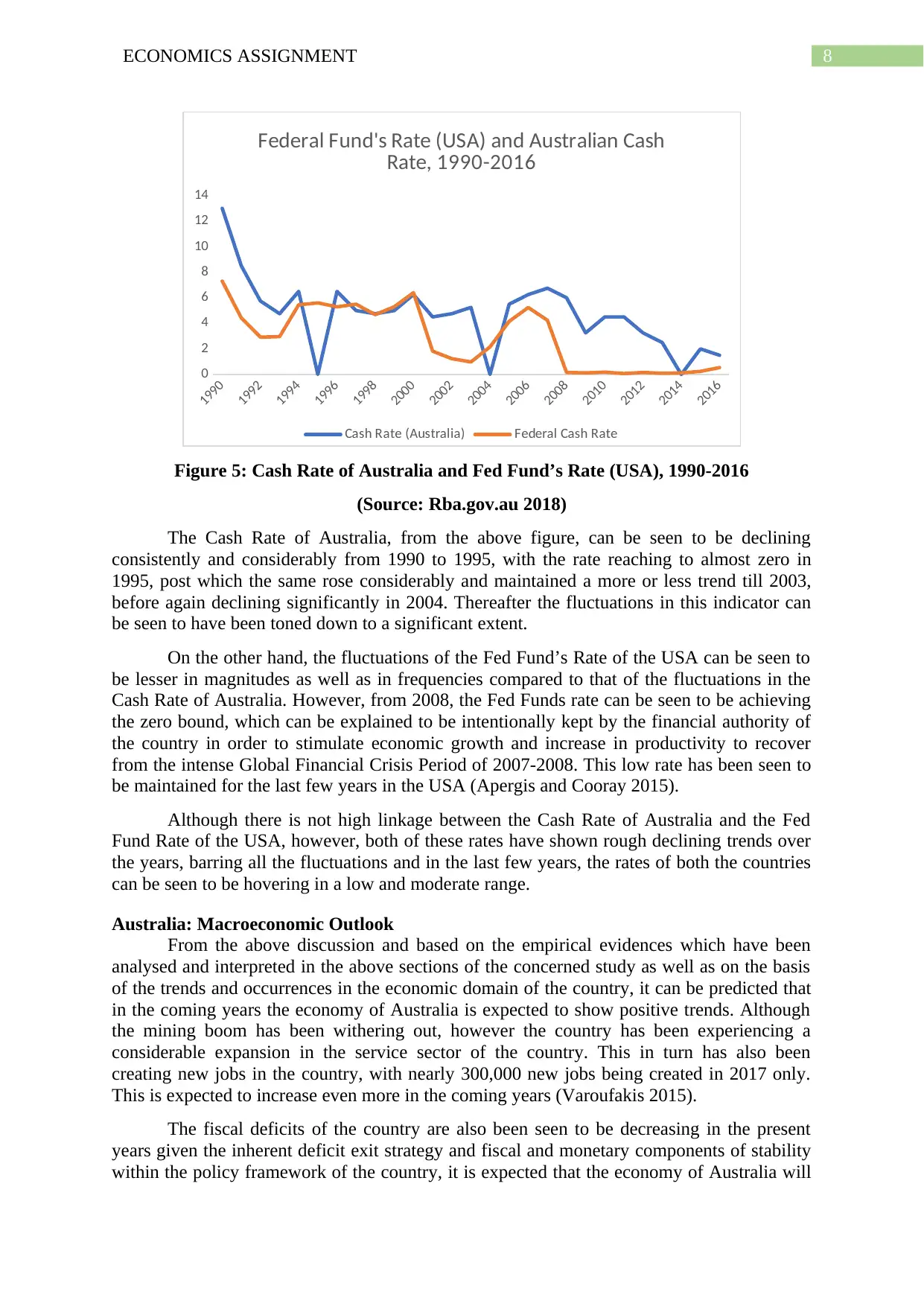
8ECONOMICS ASSIGNMENT
1990
1992
1994
1996
1998
2000
2002
2004
2006
2008
2010
2012
2014
2016
0
2
4
6
8
10
12
14
Federal Fund's Rate (USA) and Australian Cash
Rate, 1990-2016
Cash Rate (Australia) Federal Cash Rate
Figure 5: Cash Rate of Australia and Fed Fund’s Rate (USA), 1990-2016
(Source: Rba.gov.au 2018)
The Cash Rate of Australia, from the above figure, can be seen to be declining
consistently and considerably from 1990 to 1995, with the rate reaching to almost zero in
1995, post which the same rose considerably and maintained a more or less trend till 2003,
before again declining significantly in 2004. Thereafter the fluctuations in this indicator can
be seen to have been toned down to a significant extent.
On the other hand, the fluctuations of the Fed Fund’s Rate of the USA can be seen to
be lesser in magnitudes as well as in frequencies compared to that of the fluctuations in the
Cash Rate of Australia. However, from 2008, the Fed Funds rate can be seen to be achieving
the zero bound, which can be explained to be intentionally kept by the financial authority of
the country in order to stimulate economic growth and increase in productivity to recover
from the intense Global Financial Crisis Period of 2007-2008. This low rate has been seen to
be maintained for the last few years in the USA (Apergis and Cooray 2015).
Although there is not high linkage between the Cash Rate of Australia and the Fed
Fund Rate of the USA, however, both of these rates have shown rough declining trends over
the years, barring all the fluctuations and in the last few years, the rates of both the countries
can be seen to be hovering in a low and moderate range.
Australia: Macroeconomic Outlook
From the above discussion and based on the empirical evidences which have been
analysed and interpreted in the above sections of the concerned study as well as on the basis
of the trends and occurrences in the economic domain of the country, it can be predicted that
in the coming years the economy of Australia is expected to show positive trends. Although
the mining boom has been withering out, however the country has been experiencing a
considerable expansion in the service sector of the country. This in turn has also been
creating new jobs in the country, with nearly 300,000 new jobs being created in 2017 only.
This is expected to increase even more in the coming years (Varoufakis 2015).
The fiscal deficits of the country are also been seen to be decreasing in the present
years given the inherent deficit exit strategy and fiscal and monetary components of stability
within the policy framework of the country, it is expected that the economy of Australia will
1990
1992
1994
1996
1998
2000
2002
2004
2006
2008
2010
2012
2014
2016
0
2
4
6
8
10
12
14
Federal Fund's Rate (USA) and Australian Cash
Rate, 1990-2016
Cash Rate (Australia) Federal Cash Rate
Figure 5: Cash Rate of Australia and Fed Fund’s Rate (USA), 1990-2016
(Source: Rba.gov.au 2018)
The Cash Rate of Australia, from the above figure, can be seen to be declining
consistently and considerably from 1990 to 1995, with the rate reaching to almost zero in
1995, post which the same rose considerably and maintained a more or less trend till 2003,
before again declining significantly in 2004. Thereafter the fluctuations in this indicator can
be seen to have been toned down to a significant extent.
On the other hand, the fluctuations of the Fed Fund’s Rate of the USA can be seen to
be lesser in magnitudes as well as in frequencies compared to that of the fluctuations in the
Cash Rate of Australia. However, from 2008, the Fed Funds rate can be seen to be achieving
the zero bound, which can be explained to be intentionally kept by the financial authority of
the country in order to stimulate economic growth and increase in productivity to recover
from the intense Global Financial Crisis Period of 2007-2008. This low rate has been seen to
be maintained for the last few years in the USA (Apergis and Cooray 2015).
Although there is not high linkage between the Cash Rate of Australia and the Fed
Fund Rate of the USA, however, both of these rates have shown rough declining trends over
the years, barring all the fluctuations and in the last few years, the rates of both the countries
can be seen to be hovering in a low and moderate range.
Australia: Macroeconomic Outlook
From the above discussion and based on the empirical evidences which have been
analysed and interpreted in the above sections of the concerned study as well as on the basis
of the trends and occurrences in the economic domain of the country, it can be predicted that
in the coming years the economy of Australia is expected to show positive trends. Although
the mining boom has been withering out, however the country has been experiencing a
considerable expansion in the service sector of the country. This in turn has also been
creating new jobs in the country, with nearly 300,000 new jobs being created in 2017 only.
This is expected to increase even more in the coming years (Varoufakis 2015).
The fiscal deficits of the country are also been seen to be decreasing in the present
years given the inherent deficit exit strategy and fiscal and monetary components of stability
within the policy framework of the country, it is expected that the economy of Australia will
⊘ This is a preview!⊘
Do you want full access?
Subscribe today to unlock all pages.

Trusted by 1+ million students worldwide
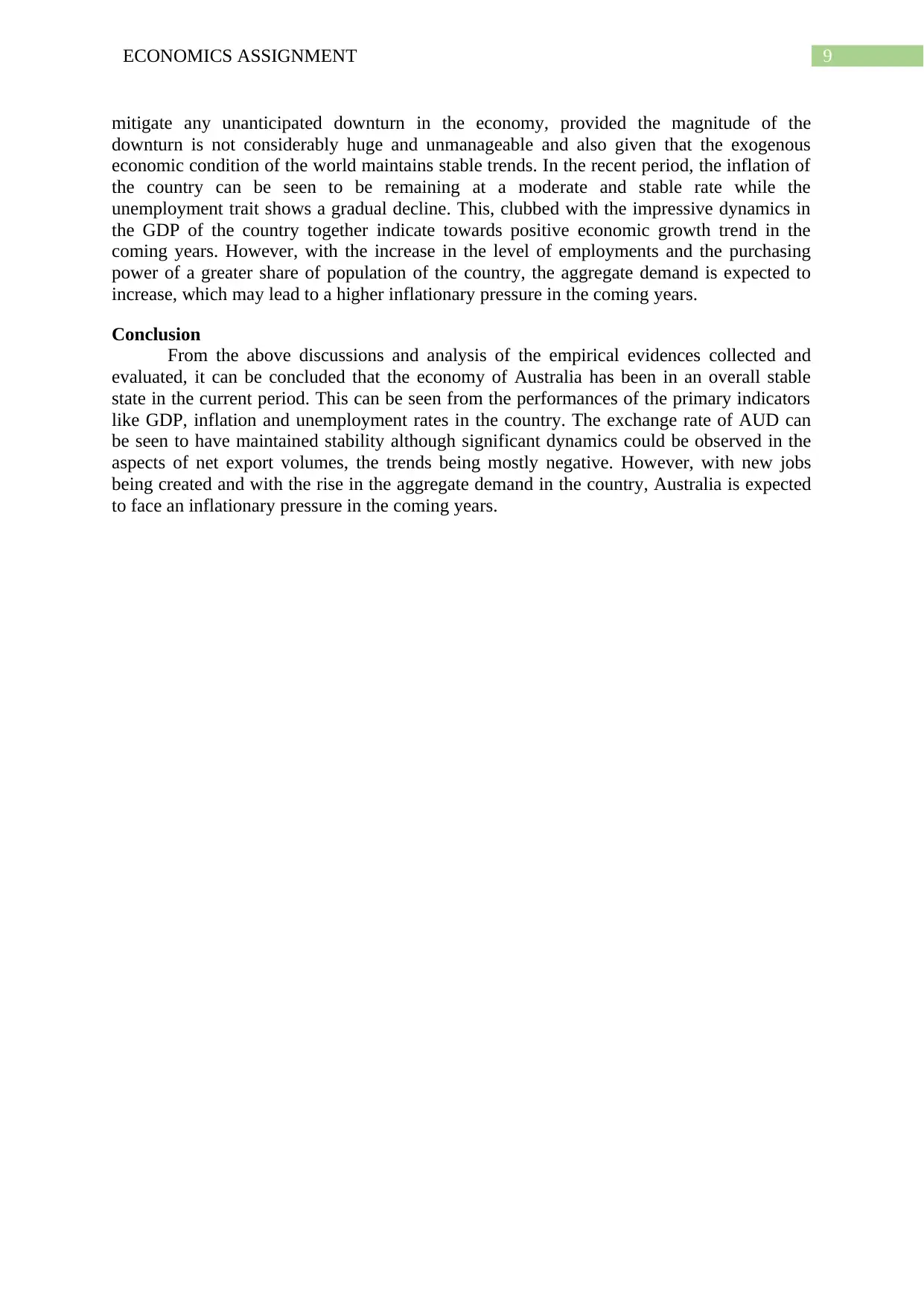
9ECONOMICS ASSIGNMENT
mitigate any unanticipated downturn in the economy, provided the magnitude of the
downturn is not considerably huge and unmanageable and also given that the exogenous
economic condition of the world maintains stable trends. In the recent period, the inflation of
the country can be seen to be remaining at a moderate and stable rate while the
unemployment trait shows a gradual decline. This, clubbed with the impressive dynamics in
the GDP of the country together indicate towards positive economic growth trend in the
coming years. However, with the increase in the level of employments and the purchasing
power of a greater share of population of the country, the aggregate demand is expected to
increase, which may lead to a higher inflationary pressure in the coming years.
Conclusion
From the above discussions and analysis of the empirical evidences collected and
evaluated, it can be concluded that the economy of Australia has been in an overall stable
state in the current period. This can be seen from the performances of the primary indicators
like GDP, inflation and unemployment rates in the country. The exchange rate of AUD can
be seen to have maintained stability although significant dynamics could be observed in the
aspects of net export volumes, the trends being mostly negative. However, with new jobs
being created and with the rise in the aggregate demand in the country, Australia is expected
to face an inflationary pressure in the coming years.
mitigate any unanticipated downturn in the economy, provided the magnitude of the
downturn is not considerably huge and unmanageable and also given that the exogenous
economic condition of the world maintains stable trends. In the recent period, the inflation of
the country can be seen to be remaining at a moderate and stable rate while the
unemployment trait shows a gradual decline. This, clubbed with the impressive dynamics in
the GDP of the country together indicate towards positive economic growth trend in the
coming years. However, with the increase in the level of employments and the purchasing
power of a greater share of population of the country, the aggregate demand is expected to
increase, which may lead to a higher inflationary pressure in the coming years.
Conclusion
From the above discussions and analysis of the empirical evidences collected and
evaluated, it can be concluded that the economy of Australia has been in an overall stable
state in the current period. This can be seen from the performances of the primary indicators
like GDP, inflation and unemployment rates in the country. The exchange rate of AUD can
be seen to have maintained stability although significant dynamics could be observed in the
aspects of net export volumes, the trends being mostly negative. However, with new jobs
being created and with the rise in the aggregate demand in the country, Australia is expected
to face an inflationary pressure in the coming years.
Paraphrase This Document
Need a fresh take? Get an instant paraphrase of this document with our AI Paraphraser
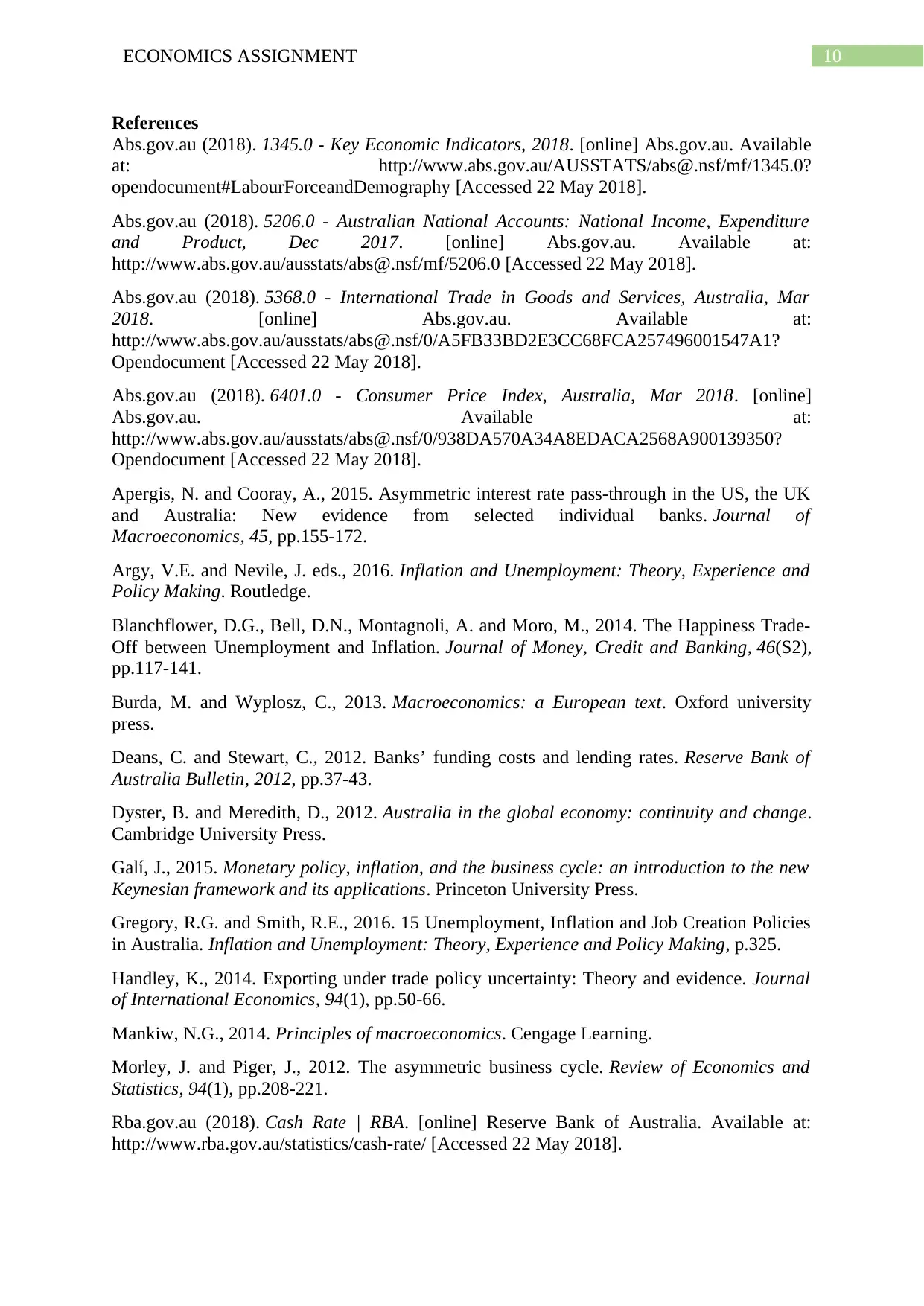
10ECONOMICS ASSIGNMENT
References
Abs.gov.au (2018). 1345.0 - Key Economic Indicators, 2018. [online] Abs.gov.au. Available
at: http://www.abs.gov.au/AUSSTATS/abs@.nsf/mf/1345.0?
opendocument#LabourForceandDemography [Accessed 22 May 2018].
Abs.gov.au (2018). 5206.0 - Australian National Accounts: National Income, Expenditure
and Product, Dec 2017. [online] Abs.gov.au. Available at:
http://www.abs.gov.au/ausstats/abs@.nsf/mf/5206.0 [Accessed 22 May 2018].
Abs.gov.au (2018). 5368.0 - International Trade in Goods and Services, Australia, Mar
2018. [online] Abs.gov.au. Available at:
http://www.abs.gov.au/ausstats/abs@.nsf/0/A5FB33BD2E3CC68FCA257496001547A1?
Opendocument [Accessed 22 May 2018].
Abs.gov.au (2018). 6401.0 - Consumer Price Index, Australia, Mar 2018. [online]
Abs.gov.au. Available at:
http://www.abs.gov.au/ausstats/abs@.nsf/0/938DA570A34A8EDACA2568A900139350?
Opendocument [Accessed 22 May 2018].
Apergis, N. and Cooray, A., 2015. Asymmetric interest rate pass-through in the US, the UK
and Australia: New evidence from selected individual banks. Journal of
Macroeconomics, 45, pp.155-172.
Argy, V.E. and Nevile, J. eds., 2016. Inflation and Unemployment: Theory, Experience and
Policy Making. Routledge.
Blanchflower, D.G., Bell, D.N., Montagnoli, A. and Moro, M., 2014. The Happiness Trade‐
Off between Unemployment and Inflation. Journal of Money, Credit and Banking, 46(S2),
pp.117-141.
Burda, M. and Wyplosz, C., 2013. Macroeconomics: a European text. Oxford university
press.
Deans, C. and Stewart, C., 2012. Banks’ funding costs and lending rates. Reserve Bank of
Australia Bulletin, 2012, pp.37-43.
Dyster, B. and Meredith, D., 2012. Australia in the global economy: continuity and change.
Cambridge University Press.
Galí, J., 2015. Monetary policy, inflation, and the business cycle: an introduction to the new
Keynesian framework and its applications. Princeton University Press.
Gregory, R.G. and Smith, R.E., 2016. 15 Unemployment, Inflation and Job Creation Policies
in Australia. Inflation and Unemployment: Theory, Experience and Policy Making, p.325.
Handley, K., 2014. Exporting under trade policy uncertainty: Theory and evidence. Journal
of International Economics, 94(1), pp.50-66.
Mankiw, N.G., 2014. Principles of macroeconomics. Cengage Learning.
Morley, J. and Piger, J., 2012. The asymmetric business cycle. Review of Economics and
Statistics, 94(1), pp.208-221.
Rba.gov.au (2018). Cash Rate | RBA. [online] Reserve Bank of Australia. Available at:
http://www.rba.gov.au/statistics/cash-rate/ [Accessed 22 May 2018].
References
Abs.gov.au (2018). 1345.0 - Key Economic Indicators, 2018. [online] Abs.gov.au. Available
at: http://www.abs.gov.au/AUSSTATS/abs@.nsf/mf/1345.0?
opendocument#LabourForceandDemography [Accessed 22 May 2018].
Abs.gov.au (2018). 5206.0 - Australian National Accounts: National Income, Expenditure
and Product, Dec 2017. [online] Abs.gov.au. Available at:
http://www.abs.gov.au/ausstats/abs@.nsf/mf/5206.0 [Accessed 22 May 2018].
Abs.gov.au (2018). 5368.0 - International Trade in Goods and Services, Australia, Mar
2018. [online] Abs.gov.au. Available at:
http://www.abs.gov.au/ausstats/abs@.nsf/0/A5FB33BD2E3CC68FCA257496001547A1?
Opendocument [Accessed 22 May 2018].
Abs.gov.au (2018). 6401.0 - Consumer Price Index, Australia, Mar 2018. [online]
Abs.gov.au. Available at:
http://www.abs.gov.au/ausstats/abs@.nsf/0/938DA570A34A8EDACA2568A900139350?
Opendocument [Accessed 22 May 2018].
Apergis, N. and Cooray, A., 2015. Asymmetric interest rate pass-through in the US, the UK
and Australia: New evidence from selected individual banks. Journal of
Macroeconomics, 45, pp.155-172.
Argy, V.E. and Nevile, J. eds., 2016. Inflation and Unemployment: Theory, Experience and
Policy Making. Routledge.
Blanchflower, D.G., Bell, D.N., Montagnoli, A. and Moro, M., 2014. The Happiness Trade‐
Off between Unemployment and Inflation. Journal of Money, Credit and Banking, 46(S2),
pp.117-141.
Burda, M. and Wyplosz, C., 2013. Macroeconomics: a European text. Oxford university
press.
Deans, C. and Stewart, C., 2012. Banks’ funding costs and lending rates. Reserve Bank of
Australia Bulletin, 2012, pp.37-43.
Dyster, B. and Meredith, D., 2012. Australia in the global economy: continuity and change.
Cambridge University Press.
Galí, J., 2015. Monetary policy, inflation, and the business cycle: an introduction to the new
Keynesian framework and its applications. Princeton University Press.
Gregory, R.G. and Smith, R.E., 2016. 15 Unemployment, Inflation and Job Creation Policies
in Australia. Inflation and Unemployment: Theory, Experience and Policy Making, p.325.
Handley, K., 2014. Exporting under trade policy uncertainty: Theory and evidence. Journal
of International Economics, 94(1), pp.50-66.
Mankiw, N.G., 2014. Principles of macroeconomics. Cengage Learning.
Morley, J. and Piger, J., 2012. The asymmetric business cycle. Review of Economics and
Statistics, 94(1), pp.208-221.
Rba.gov.au (2018). Cash Rate | RBA. [online] Reserve Bank of Australia. Available at:
http://www.rba.gov.au/statistics/cash-rate/ [Accessed 22 May 2018].

11ECONOMICS ASSIGNMENT
Schneider, F., 2012. Size and development of the shadow economy of 31 European and 5
other OECD countries from 2003 to 2012: some new facts. Accessed June, 13, p.2015.
Thurbon, E., 2015. 10 years after the Australia-US free trade agreement: where to for
Australia’s trade policy?. Australian Journal of International Affairs, 69(5), pp.463-467.
Varoufakis, Y., 2015. The global minotaur: America, Europe and the future of the global
economy. Zed Books Ltd..
Schneider, F., 2012. Size and development of the shadow economy of 31 European and 5
other OECD countries from 2003 to 2012: some new facts. Accessed June, 13, p.2015.
Thurbon, E., 2015. 10 years after the Australia-US free trade agreement: where to for
Australia’s trade policy?. Australian Journal of International Affairs, 69(5), pp.463-467.
Varoufakis, Y., 2015. The global minotaur: America, Europe and the future of the global
economy. Zed Books Ltd..
⊘ This is a preview!⊘
Do you want full access?
Subscribe today to unlock all pages.

Trusted by 1+ million students worldwide
1 out of 12
Related Documents
Your All-in-One AI-Powered Toolkit for Academic Success.
+13062052269
info@desklib.com
Available 24*7 on WhatsApp / Email
![[object Object]](/_next/static/media/star-bottom.7253800d.svg)
Unlock your academic potential
Copyright © 2020–2025 A2Z Services. All Rights Reserved. Developed and managed by ZUCOL.





